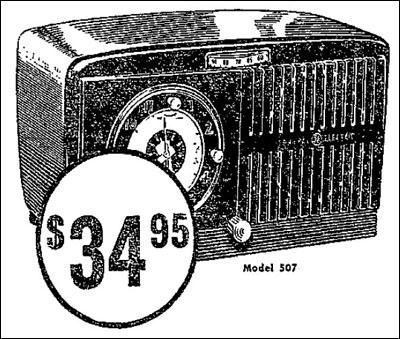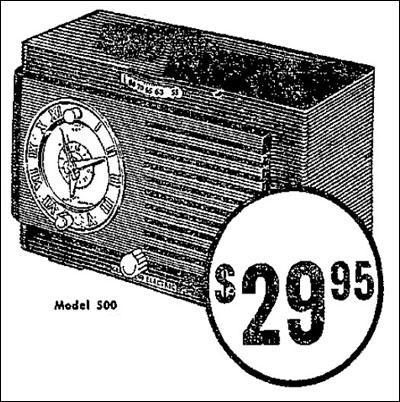Of Old Radios And Related Items--Published Monthly
General Electric Model Diversity
BY STEVE AUYER AND LOREN ASHWORTH
Web Edition
The following article demonstrates the kind of interconnection A.R.C. fosters among collectors. It's really a follow-up to a follow-up. Steve Auyer's article on glow-in-the-dark radios in the April 2007 issue prompted a response from Loren Ashworth in the July issue. And with a little more prompting from A.R.C., they got together on a broader subject about diversity in GE models of the 1940s. (Editor)
About his Model T, Henry Ford is reputed to have said, "You can buy it in any color you want -- as long as it is black." And for many years, radio manufacturers had the same philosophy. Other than the brightly colored Catalin radios of the 1930s and a few other distinctively styled radios, radios came in wood finished cabinets. Initial production of Bakelite cabinets was generally in wood-toned brown, but by the early 1940s, General Electric was offering its table radios either in the traditional brown cabinet or in an ivory-colored version.
Following World War II, the company began introducing color as a marketing tool in its lines of consumer products. By the mid-1950s, kitchen appliances were offered in pastel shades of pink, blue, and yellow, in addition to the traditional white. And, of course, we remember the more brightly colored avocado, yellow and harvest brown colors of the 1960s.
The Clock Radio Line
A popular product of the time was the clock radio. General Electric promoted their use: "In the bedroom -- Lulls you to sleep, then turns itself off. Wakes you on time to sweet music -- automatically!"; "In the kitchen -- Electronic Servant starts breakfast -- turns on coffee-maker, dozens of electric appliances -- all automatically!" And "In any room -- Turns on a favorite radio program automatically. Beautiful tone. G-E electric clock tells time even in dark." [But only if you bought the model with the radium dial.]
In the late 1940s, General Electric would take a standard radio chassis and offer it packaged in several different cabinet styles and colors. Typical was the 1949 clock radio line that was offered as Models 64, 65, 500, 501, 505, 506, 507, 508, 509 and 530, depending upon cabinet style and color.
Figure 1. Artwork from promotional material supplied to distributors who, in turn, gave it to the stores. Shown are Model 507, top, and Model 540, bottom.Cabinet Styles and Colors
Figure 1 shows the two basic cabinet styles, and it is interesting to note that the same basic radio, when packaged in a more smoothly styled cabinet, had a list price $5 higher than the traditionally styled cabinet. Cabinets were offered in "Rich Rosewood, Lovely Ivory, Beautiful Burgundy, White, and Modern Bleached Mahogany." This range of colors might have been a bit of overkill as the following year the list was pared to "Congo Brown, Alabaster Ivory, Persian Red, and Porcelain White."
The Chassis
Figure 2 (courtesy of Howard Sams Photofact - see print version) shows the basic chassis. There are several interesting features, the first being the size of the chassis cutouts for the tube sockets. In the late 1940s, demand for vacuum tubes outstripped production, and the designers wanted the freedom to use whichever tube model was available -- either a 35W4 or 35Z5 rectifier, for example. Thus the chassis cutouts were sized for octal-based tubes and filled with special sockets if 7-pin miniature tubes were available.
On the back of the chassis, you will note a small sub-chassis that contains an electrical outlet that is controlled by the clock timer, and also a slide switch that can be used to override the clock timer. Again, General Electric offered several options here: Models 64 and 65 did not have the sub-chassis; Models 505, 506, 507 and 508 had only an outlet on the sub-chassis; and Models 509 and 530 had the timer override switch in addition to the outlet.
If you look at a section of the Sams parts list in Figure 3 (see print version) you'll note that depending upon the specific model that you were working on, you had to select one of four different loop antennas, one of two different power switches, and one of four different dial scales. But, if this annoyed the serviceman, think of the headaches it gave the poor production control guy on the manufacturing line who had to make sure the kits contained the right mix of parts for the model being produced.
The Telechron Mechanism
This radio, like most other clock radios, wall and desk clocks, and appliances of the era used a Telechron mechanism in the clock. The Telethon mechanism, shown in Figure 4 (see print version), consisted of an AC coil and a sealed rotor and gear assembly with a single output shaft. A series of external gears would drive the hour and minute hands from the output shaft. Occasionally, an AC coil would fail and the repairman could obtain a replacement for this part.
The sealed rotor and gear assembly had a tendency to get "noisy" after long use. This would often take the form of a faint grinding noise that was most annoying when it was coming from a clock radio and the owner was trying to get to sleep. The unit would still keep accurate time but the noise would eventually become louder and louder. Finally, the crunching/grinding could be heard across a room, and it was time to do something.
Replacement rotor and gear assemblies were available, but they were fairly expensive. As a result, many radio repairmen made a "quick fix" by drilling a small hole in the rotor housing, squirting in a few drops of WD-40, and then sealing the hole with tape. Ah, the ingenuity of the radio servicemen of those days.
These days, of course we're back to the "one color fits all" mode of operation. Still, it's interesting to think back to the days when the buyer had to choose not only the manufacturer and model number, but also the color of the cabinet!
Steve Auyer has been interested in the history of radio since he toured the WLW 500 KW transmitter site in 1963. Lately, his interests have turned to researching and documenting local AM broadcasting history. Since his retirement from Lockheed Martin, he has spent time coordinating the Amateur exhibit at the Museum of Science & Technology in Syracuse, New York.
Loren Ashworth trained in radio and TV at the Coyne Electrical School and served in the U.S. Army Signal Corp. in the early 1960s. Self-employed since 1968, he does commercial and industrial sound jobs, as well as some TV and radio installation and repair.
|
[Free Sample] [Books, etc., For Sale] [Subscribe to A.R.C./Renew] [Classified Ads] [Auction Prices] [Event Calendar] [Links] [Home] [Issue Archives] [Book Reviews] [Subscription Information] [A.R.C. FAQ]URL = http://www.antiqueradio.com/Mar08_Auyer_GE.html Copyright © 1996-2008 by John V. Terrey - For personal use only. Last revised: March 2, 2008. For Customer Assistance please contact ARC@antiqueradio.com or call (866) 371-0512 toll free Antique Radio Classified |

